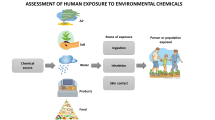Organic pollutants in food, environment and human biomonitoring studies
Industrial contaminants in the food chain
Human population uses a number of chemicals on a daily basis that can be released into the environment, where they can have negative effects and persist for a long time. These compounds can be found in various environmental compartments, including water, air, or soil, which together with sediments can represent a significant reservoir of persistent substances. Undesirable substances penetrate into environment by various ways, including atmospheric deposition, the use of contaminated water for irrigation or through accidental spills.
Our research group has been involved in the analysis of environmental contaminants for a long time. From the group of persistent organic pollutants (POPs), we focus on brominated flame retardants. (BFR), polychlorinated biphenyls (PCBs), organochlorine pesticides (OCPs), chlorinated paraffins (CPs), perfluoroalkylated substances (PFAS), but also polycyclic aromatic hydrocarbons (PAHs), phthalates, UV filters, organophosphate flame retardants (OPFRs). In many studies, we monitor these chemicals not only in food and food supplements, but also in environmental compartments such as air, dust, sediments, soil, water, etc. Recently, we have been analyzing these compounds in food contact materials and other object of everyday use as they represent significant sources of human exposure to these chemicals. Within the research projects, we develop the required multianalytical methods, in which gas or liquid chromatography coupled with mass spectrometry is used as an instrumental technique.
Publications
- Drabova L., Dvorakova D., Urbancova K., Gramblicka T., Hajslova J., Pulkrabova J.: Critical Assessment of Clean-Up Techniques Employed in Simultaneous Analysis of Persistent Organic Pollutants and Polycyclic Aromatic Hydrocarbons in Fatty Samples. Toxics (2022), 10 (1),12. (doi: 10.3390/toxics10010012)
- Jurikova M., Dvorakova D., Pulkrabova J.: The occurrence of perfluoroalkyl substances (PFAS) in drinking water in the Czech Republic: a pilot study. Environmental Science and Pollution Research (2022) published (doi: 10.1007/s11356-022-20156-7)
- Tomasko J., Hrbek V., Kourimsky T., Stupak M., Hajslova J., Pulkrabova J.: Are fish oil-based dietary supplements a significant source of exposure to chlorinated paraffins? Science of the Total Environment (2022) 833, 155137. (doi: 10.1016/j.scitotenv.2022.155137)
- Tomasko J., Stupak M., Hajslova J., Pulkrabova J.: Application of the GC-HRMS based method for monitoring of short- and medium-chain chlorinated paraffins in vegetable oils and fish. Food Chemistry (2021) in press. (doi: 10.1016/j.foodchem.2021.129640)
- Polachova A., Gramblicka T., Parizek O., Sram R.J., Stupak M., Hajslova J., Pulkrabova J.: Estimation of human exposure to polycyclic aromatic hydrocarbons (PAHs) based on the dietary and outdoor atmospheric monitoring in the Czech Republic. Environmental Research (2020) 182: 108977. (doi: 10.1016/j.envres.2019.108977)
Projects
- GAČR - Vliv nových chlorovaných kontaminantů na adipogenezi, 21-19437S, 01/2021 – 12/2023
- Horizon 2020 - PAPILLONS - Plastic in Agricultural Production: Impacts, Lifecycles and Long-term Sustainability, 101000210, 6/2021 - 5/2025
- EFSA - Screening for emerging chemical risks in the food chain, OC/EFSA/SCER/2020/02, 02/2021 – 01/2024
Biomonitoring, exposom
Today, humans are exposed to mixtures of chemicals that are released into the environment from various commercial and industrial applications. Some of them can have an adverse effect on human health. Therefore, it is necessary to monitor the quality of the environment and to assess its impact on humans. For this purpose, human biological monitoring (biomonitoring) is applied and provides, which provides data on the amount of chemicals and their metabolites in the body by analyzing suitable biological samples, such as blood serum / plasma, urine, breast milk, etc.

|
„Human Biological Monitoring“, Zielhuis, 1984
|
Our research group has been involved in European biomonitoring for many years. We develop multianalytical procedures based on chromatography and mass spectrometry, which meet the requirements of ultratrace analysis for the determination of different groups of environmental contaminants in one analysis. The group of persistent organohalogenated pollutants are represented by brominated flame retardants, polychlorinated biphenyls, chlorinated pesticides, chlorinated paraffins, perfluoroalkylated compounds, but also polycyclic aromatic hydrocarbons, phthalates, UV filters, organophosphate flame retardants, including their metabolites.
Publications
- Nübler S., Lopez M. E., Castano A., Mol H. G. J., Haji-Abbas-Zarrabi K., Schäfer M., Hajslova J., Dvorakova D., Antignac J.-P., Koch H. M., Huag L. S., Vorkamp K., Göen T.: Interlaboratory Comparison Investigations (ICIs) and External Quality Assurance Schemes (EQUASs) for human biomonitoring of perfluoroalkyl substances (PFASs) in serum as part of the quality assurance programme under HBM4EU. Science of The Total Environment (2022) 847: 157481 (doi: 10.1016/j.scitotenv.2022.157481)
- Ambroz A., Rossner Pavel Jr., Rossnerova A., Honkova K., Milcova A., Pastorkova A., Klema J., Pulkrabova J., Parizek O., Vondraskova V., Zelenka J., Vrzackova N., Schmuczerova J., Topinka J., Sram R.J.: Oxidative Stress and Antioxidant Response in Populations of the Czech Republic Exposed to Various Levels of Environmental Pollutants. Environmental Research and Public Health (2022). 19, 3609. (doi: 10.3390/ijerph19063609)
- Cerna M., Grafnetterova A.P., Dvorakova D., Pulkrabova J., Maly M., Janos T., Vodrazkova N., Tupa Z., Puklova V.: Biomonitoring of PFOA, PFOS and PNFNA in human milk from Czech Republic, time trends and estimation of infant’s daily intake.Environmental Research (2020) in press. (doi: 1016/j.envres.2020.109763)
- Dvorakova D., Pulkrabova J., Gramblicka T., Polachova A., Buresova M., Hajslova J., López M.E., Castaño A., Nübler S., Haji-Abbas-Zarrabi K., Klausner N., Göen T., Mol H., Koch H.M., Vaccher V., Antignac J.-P., Haug L.S., Vorkamp K.: Interlaboratory Comparison Investigations (ICIs) and External Quality Assurance Schemes (EQUASs) for Flame Retardant Analysis in Biological Matrices: Results from the HBM4EU Project. Environmental Research (2021) 202: 111705. (doi: 10.1016/j.envres.2021.111705)
- Polachova A., Gramblicka T., Bechynska K., Parizek O., Turnerova, Dvorakov, Honkova K., Rossnerova A., Rossner P., Sram R.J., Topinka J., Pulkrabova J.: Biomonitoring of 89 POPs in blood serum samples of Czech city policemen. Environmental Pollution (2021) 291: 118140(doi: 10.1016/j.envpol.2021.118140)
- Urbancova K., Sram R.J., Hajslova J., Pulkrabova J.: Concentrations of Phthalate and DINCH Metabolites in Urine Samples from Czech Mothers and Newborns. Exposure and Health (2021) 14: 17-27 (doi: 10.1007/s12403-021-00415-7)
Projects
- GAČR - Vliv nových chlorovaných kontaminantů na adipogenezi, 21-19437S, 01/2021 – 12/2023
- Horizon Europe - PARC - European Partnership for the Assessment of Risks from Chemicals, HORIZON-HLTH-2021-ENVHLTH-03, No. 101057014, 5/2022 - 4/2029
